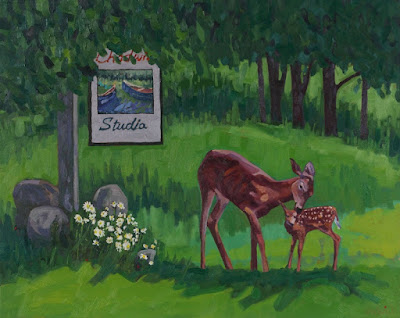 |
#2676 "Singleton Cumulus Congestus Showers"
8x10 oils stretched canvas |
Initially I was just going to include the one central towering cumulus shower but there were more. As a result, I had to change the name of this painting. There was also a lot of meteorology revealed by those lines of showers and I thought I would use the painting to explain why those clouds and showers arrived at Singleton on the Friday afternoon in June.

The cooler air mass in the wake of the cold front was ignited by the strong June sun. Lines of cumulus congestus were shaped by the lake breezes within the landscape of the background, brisk westerly surface winds. The lake shadow from Georgian Bay extended far toward the southeast and even merged with the Lake Ontario shadow into New York State. A lake breeze convergence line developed along the north shore of Lake Ontario. The waters of Lake Ontario were still very cold and the June sun was enough to create a strong contrast in temperature between the water to the land. That Lake Ontario convergence line was forced to stay along the shore of the lake by the west winds. The northeastern flank of Georgian Bay was responsible for shaping the line of convection that approached Singleton Lake that Friday afternoon. Interesting secondary lines of convection were formed by the Penetanguishene Peninsula and the Bruce Peninsula.

The observed surface winds were westerly but the lake breeze convergence lines were oriented from the northwest. This was explained in "
Adding Friction to the Wind Balance" which described how friction caused the gradient wind at the top of the planetary boundary layer to turn and point toward lower pressure near the surface. Increased friction slows the wind and the balance of forces shifts the wind direction to point more down the "pressure mountain" to compensate for the decreased speed. The typical difference between the wind direction in the free atmosphere at the top of the planetary boundary layer and the surface wind is about 45 degrees. The clouds are aligned with the winds through their convective depth near the top of the planetary boundary layer and well above the surface. Those cloudy, convergence lines make about a 45 degree angle with the westerly surface winds. All of this is clearly revealed on the satellite imagery.
Shoreline induced convergence lines rely on a single inland penetrating lake breeze vector whereas peninsula convergence lines often make up for their relatively smaller size by benefiting from two, colliding lake breeze vectors. The lake shadow downstream from a bay is especially pronounced by the divergent lake breezes and the associated subsidence.
Every line of convection can be explained and understood. Science tends to start with the more obvious features like those detailed in the accompanying graphic. Meteorologists then drill down into the details where the pesky devil can be found. I made a big part of my meteorological career out of understanding lake breezes and how they influence severe convection whether that dangerous weather be thunderstorms or snow squalls. Weather is neither random or unpredictable although it might often appear that way.
For this and much more art, click on Pixels. Thank you.





































